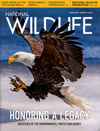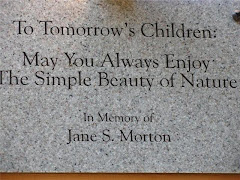(A-59) NATURE DEFICIT DISORDER & WILDLIFE-FRIENDLY YARDS
 Note: Scroll down right-hand margin to "(A-59) Attention Deficit Disorder" for free videos on this topic.
Note: Scroll down right-hand margin to "(A-59) Attention Deficit Disorder" for free videos on this topic.
 |
| Click to learn more! |
As more and more children spend time indoors near electrical sockets, there are a gathering  number of people converting sections of their lawn into wildlife-friendly spaces. I just read a neat article about a couple in Oakdale, CA, who made their backyard into a wildlife haven. Glenn and Nancy Skuta also qualified for the National Wildlife Federation’s certified backyard program.
number of people converting sections of their lawn into wildlife-friendly spaces. I just read a neat article about a couple in Oakdale, CA, who made their backyard into a wildlife haven. Glenn and Nancy Skuta also qualified for the National Wildlife Federation’s certified backyard program.
And talk about free entertainment at home! They have a path lined with purple and white irises where hummingbirds fly sorties over. Cardinals, sing from the trees and deer hoof prints can be found in the soft earth. They can escape to their at-home sanctuary and enjoy nature’s peace.
 The National Wildlife Federation (NWF) teaches how to create a wildlife-friendly garden. Click HERE to go directly to their
The National Wildlife Federation (NWF) teaches how to create a wildlife-friendly garden. Click HERE to go directly to their  certification site. Certification is quite easy and requires the habitat to include four things for the wildlife: food, water, cover and a place for young to be raised. And, one must use environmentally sustainable gardening practices. Then, a short description and a sketch of how the garden looks is needed for your property to become certified by NWF. The Skutas' backyard has been certified for 15 years and has a variety of plants growing and animals visiting throughout the year. According to the newspaper article in the Oakdale Patch, “many of the birds return every year to the backyard: the same cardinals have been returning for the past three years. Nancy Skuta noticed the hummingbirds not only stop at the feeders for food but also from the flowers in the backyard.”
certification site. Certification is quite easy and requires the habitat to include four things for the wildlife: food, water, cover and a place for young to be raised. And, one must use environmentally sustainable gardening practices. Then, a short description and a sketch of how the garden looks is needed for your property to become certified by NWF. The Skutas' backyard has been certified for 15 years and has a variety of plants growing and animals visiting throughout the year. According to the newspaper article in the Oakdale Patch, “many of the birds return every year to the backyard: the same cardinals have been returning for the past three years. Nancy Skuta noticed the hummingbirds not only stop at the feeders for food but also from the flowers in the backyard.”
 The NWF’s Garden for Wildlife website lists ways to garden in an environmentally friendly way. Most yards contain a simple garden but not as extensive as the NWF requires. One of the Skuta’s neighbors positioned a chair in his home in order to sit and view the garden.
The NWF’s Garden for Wildlife website lists ways to garden in an environmentally friendly way. Most yards contain a simple garden but not as extensive as the NWF requires. One of the Skuta’s neighbors positioned a chair in his home in order to sit and view the garden.
 |
| Click to learn more! |
“It was a nice compliment,” Nancy Skuta said. “While it might be a little different in an urban setting, it is a source of enjoyment for us and neighbors.”
They observe birds flying and singing, deer eating from their crabapple tree, various wildlife eating and interacting in the yard, goldfinches bathing in the bird bath...hmm, could this be a way for parents to battle the growing Nature-Deficit Disorder among our children?
Robert Morton, M.Ed., Ed.S. writes about transforming urban sprawl into wildlife-friendly spaces, one yard at a time! Click HERE to read his story. A percentage of income from ad sales is donated to the Black Swamp Bird Observatory. Have you created a wildlife-friendly space in your yard? We'd enjoy posting it! Contact us at the secure Bpath Mail Form.



